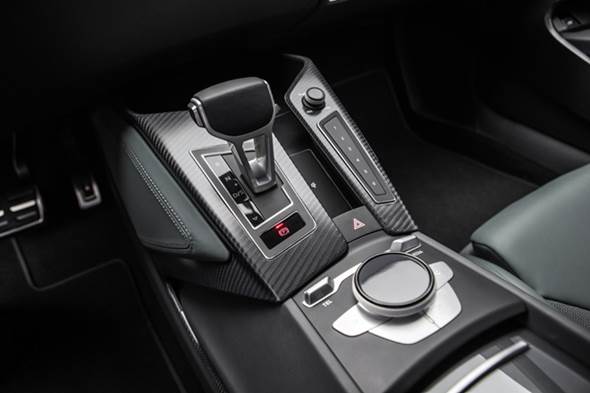Around midday, both sports cars meet at the local filling station. The new car has a 90-liter tank, which is big enough to provide a 644 km/l range, despite the hefty average fuel consumption of 7.08 km/l. On a good day, the surprisingly softly voiced classic coupé can accelerate from 0 to 100 km/h in 4.5 seconds and on to a top speed of 248 km/h. Below 3,000 RPM, the high-boost-pressure version of the longitudinally mounted 20-valver is a sleeper. Around 3,500 RPM, however, Mr. Hyde and Dr. Jekyll swap saddles. All of a sudden, the five-ender bites like a piranha that has licked blood. The needle-shaped torque curve peaks at 3,700 RPM where 350 Nm is on tap, but you are welcome to rev the engine to the limiter at 7,000 RPM. The charger whine becomes louder and louder as the final 3,000 RPM stack up, turbo lag can now be counted in split rather than full seconds, and every inspired upshift is prompted by a long, high-pitched waste-gate whistle. The steering is very quick, de throttle turn-in can make your blood pressure soar (and the car carousel), and the turning circle is a tight 10.3 m. Although handicapped by small 15-inch wheels, the inner-ventilated steel discs are 295 mm in diameter, 28 mm thick and straddled by potent four-piston calipers. Helped by the light weight, slamming on the brakes in this 1984 pseudo-racer still smashes the brain against the forehead with the same vigor as in a modern car.

Predictably, the reincarnation completed in 2013 can decelerate with even greater aplomb. Given half a chance, the XXXL carbon-ceramic rotors and the golden Brembo stoppers would effectively scalp those fat low-profile 285/30 ZR21 Pirellis. Having said that, the intense brake action is actually pleasantly progressive, and if anything the pedal feel is a touch on the light side. The steering takes only 2.3 turns from lock to lock, and, thanks to the shorter wheelbase, the coupé needs even less space to manoeuver between kerbs than the RS7.
Unlike all existing S and RS Audi models, this one-off head-turner actually transmits loads of driving feel through its helm. The fight for lateral grip, the constantly changing torque feed, the impressive stopping power and the sublime vertical terrain control merge in a seismic, haptic and organic flow, which is exceptional for a production car and little short of sensational for a concept vehicle. There is very little lean even through corners taken at adventurous speed, pitch and yaw are well suppressed, and although the dampers are not yet adjustable in this number one specimen, the ride is neither hard-edged nor choppy. The hybrid application helps to generate a perfect 50:50 weight distribution, an unusually low center of gravity and ground-hugging road-holding.

While the show car has a large provisional single-piece tail section molded from lightweight fibers, the production model would get a tall and deep tailgate with an integrated motorized air dam, which extends above 113 km/h and recedes below 80 kmh. the advanced airflow management is executed by louvers in the bonnet, which speed up the engine cooling, lateral breathers in the wings to ventilate the wheelhouses, low-drag mirrors, concealed door handles with integrated proximity sensors, a prominent CFK front splitter and a DTM-style rear apron. Like all future Audi sports cars, the honeycomb grille is complemented by two lower apertures with vertical black strakes. The four rings are no longer part of the grille, but sit prominently on the bonnet.
The dashboard is structured by a contrasting wrap-around band, which incorporates the window switches and door latches. The cabin looks like a double-tub four-seat carbon-fiber cradle, fitted with minimalistic race buckets featuring folding clamshell backrests and integrated head restraints. Behind the fixed rear seats there’s a lightweight cross brace. For cost and complexity reasons, the body structure consists of high-strength steel. While the roof will be made of carbon-fiber, the doors, the bonnet and the boot-lid are to be stamped from sheet aluminum. Unlike its forerunner, which boasts of double wishbones all-round, the re-born Quattro mates a five-link front axle to a multi-link rear suspension.

In total there have been four Quattro concepts since 2010, and three different R&D bosses have failed to get them into production, but surely this is the final and definitive attempt at re-creating Audi’s legendary sports car. If it gets the nod, F13 will almost certainly be built at the Böllinger Höfe facility of Quattro GmbH, home of the DTM racers and the ALMS cars. Since the proposed road-going Le Mans car (Scorpio/R20) was sidelined, the go-faster division has again got the space and the manpower to handle a new project. F13 would almost certainly be priced below $246,340, and might only be available in left-hand drive. After all, its main markets are North America, China and Germany. In case demand outstrips supply, Audi might be tempted to add 1,500 or 2,000 Sport Quattro roadsters. We may eventually also see an even pricier GT model with a twice-as-potent 304 PS electric motor.
Unlike the original Sport Quattro, this is not a limited-edition special conceived for motor sport purposes. Instead, it’s an image-maker, a brand ambassador and evidence that the ‘Vorsprung durch Technik’ motto is not just a hollow promise. Now the bean counters must prove it. And if they’re in doubt, maybe they should do what I did: drive it.
Specifications Price: $246,340 Engine: 3,993 cc 32v twin-turbo V8, 560 PS at 5,700-6,600 RPM, 700 Nm at 1,750-5,500 RPM, plus electric motor, 150 PS, 400 Nm at zero RPM; total: 700 PS, 800 Nm Transmission: Eight-speed auto, four-wheel drive Performance: 3.7 sec 0-100, 307 km/h, 40.2 km/l Suspension: McPherson Strut front, multi-link rear Weight: 1605kg Length/Width/Height: 4,602/1,964/1,386 mm Rating: 5/5 |